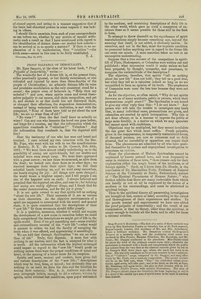< The "Conservation of Energy" in Relation Certain Views of the Theosophists (continued from page 7-136) >
with those which are observable and calculable, when we consider the movement of bodies in planetary space. We are ourselves at the present moment moving, with our earth in its orbit round the sun, with a velocity of over 87,000 feet per sec., and some of the stupendous currents at the surface of the sun have been observed to move with a velocity of 100 miles per second.
We may now consider whether the separation of molecules is attended with a conversion of work into potential energy, We have here a magneto-electric machine, by means of which we can force asunder the oxygen and hydrogen atoms, or molecules, which, when combined, constitute water. The fluid is thus converted into a mixture of the two gases, You perceive that my assistant has to work pretty hard in order to evolve the bubbles of gas which are now rising through the fluid and filling the bottle. I may as well at once tell you, whilst we are waiting, that 743 foot-pounds of work have to be expended in order to decompose one grain of water—in addition to the work required in order to overcome the friction of the machine and to urge the electric current through the wire portion of the circuit. This work becomes stored up in the liberated gases as 'potential energy of chemical separation. When the gases are caused to recombine, by means of a flame applied to the mouth of the bottle, this is suddenly converted into actual energy, which becomes evidenced by an explosive effect of expansion, and which ultimately assumes the form of heat. By this experiment three very important facts are brought into evidence: 1st, that In the separation of the constituent atoms, or molecules, of compound bodies, work becomes stored up as potential energy (of chemical separation); 2ndly, that When atoms, or Molecules, fall together, potential energy becomes converted into heat; and, 3rdly, that Heat is a mode or form of energy.
We now place a rather thin platinum wire in the circuit of the machine. Observe that the moment my assistant begins to work the machine the wire becomes red, and afterwards white hot. For every 772 foot-pounds of work expended by him, in addition to the work required to overcome friction, &c. (which also takes the form of heat), a unit of heat, i.e., sufficient heat to raise the temperature of 1 lb. of water by 1 degree Fahrenheit, is generated in the wire. This value, 772 foot-pounds, is known as the mechanical equivalent of heat. It was determined by Prof. Joule, through the process of churning water—an operation in which energy would formerly have been supposed to be utterly lost and annihilated.
We are now, I think, in a position to form at least a very shrewd guess as to what becomes of kinetic energy when the motion of a body is suddenly arrested. The rectilinear motion is, in fact, converted into the vibratory motion we term heat. If we pick up a rifle bullet after it has struck the target, we find that it is hot. At Shoeburyness a flash of light may be seen when the projectiles strike the armour plates. It is amply demonstrated by experiment as well as by inductive reasoning that a unit of heat is produced for every 772 foot-pounds of kinetic energy disappearing. And perhaps the reference that has been made to the enormous velocities which occur in our solar system may have prepared you for the statement that the heat and light of the sun are due to the conversion of kinetic energy. So far from the sun being, as is popularly supposed, a huge bonfire, it is improbable that anything of the nature of combustion takes place upon its surface. Its heat, which is the source, directly or indirectly, of nearly the whole of the energy manifested as motion and life on the surface of our earth, is derived indubitably from asteroids, which with enormous velocity impinge upon its surface. Like Saturn, the sun is devouring his own children; and there is no doubt but that first Mercury, then Venus, and next the Earth and its moon will ultimately supply it with kinetic energy, and form portion of its mass.
There is one important bearing, which should at least be mentioned, of the present subject matter upon some of the marvellous phenomena which take place at our seances, There is no doubt whatever but that physical energy, frequently measured by hundreds of foot-pounds, is exerted and converted by agents other than the medium and sitters—as, for instance, in the floating of a heavy musical box round the room. The moment we have satisfied ourselves that this energy, or “power,’’ is derived or “drawn” from the medium and sitters, it becomes from our point of view almost certain that something material—ponderable matter, or “psychical matter”—in which potential energy has been previously stored up by the separation of molecules, and through which work may be done by the conversion of energy as those fall together, is actually taken from them by the manifesting agent. It is probable also that this vehicle for energy is ultimately restored to the medium and sitters, in order that energy may again be stored up in it from the food which is taken into the system.
And now, in conclusion, what are we to say, what can we say, in reference to that portion of the u views of the Theosophists” which relates to “elemental” spirits?* Rerum causis superfluis Natura non luxuriat! Is it not evident that these “errant unthinking, soulless forces of nature” must be relegated to the limbo of hermetic, cabalistical, and mediaeval superstitions? Can we make any essential distinction between the kinetic energy of a mass of air or water, moving with a certain velocity, and that of a railway train or a projectile also in motion? Is the “force of the wind, the fire, the flood” to be an elemental spirit, and that of the truck or cannon ball a more material kind of energy? Or is it also an elemental that animates Master Tommy’s cricket ball and marbles? In any case, we should certainly like to know what is the minimum number of foot-pounds constituting or equivalent to one of these “creatures of immutable law.” And we should also particularly like to have some estimate of the quantity of energy stored up in a single drop of “the most pure liquor,” previously referred to, which fed the “burning lamp” mentioned by Scardeonius, and, I fear, more or less believed in by certain Theosophists. We could then form an idea of the destructive effects which would ensue if the drop in question were thrown upon the fire, and perhaps make some interesting comparisons between it and dynamite or other powerful explosives.
* Vide The Spiritualist, December 7th, 1877.

<Untitled> (The first of a series of three...)
Miss Poyntz’s Matinees.—The first of a series of three matinees was given by Miss Katherine Poyntz on Saturday last, at 28, Park-crescent, Regent’s-park,'London (the residence of Mr. and Mrs. Arbuthnot), before a brilliant audience. Mr. Brandram recited Shakespeare’s Tempest in a masterly style, and the incidental vocal music was rendered by Miss Poyntz, Madame Gilardoni, Mr. Raynham, and Mr. Pyatt; Mr. Duggan conducted at the pianoforte. Miss Poyntz soars far above the level of the ordinary concert-room style; whatever she undertakes is rendered with a finish and completeness which the public has noticed from the very first at the classical concerts given by her at St. George’s Hall three years ago, where she made her mark as an artist. She was ably sustained on the present occasion by her coadjutors. One of “Caliban’s” songs, composed by Mr. Duggan, and sung effectively by Mr. Pyatt, was a masterly composition. The second matinee will be on the 30th inst., when “Tiny,” the celebrated infant elocutionist, aged seven, will take part; and at the third, on the 8th of June, Mr. Brandram will again recite: the play on that occasion will be The Midsummer Night's Dream, with musical illustrations. The play of The Tempest should please the Occultists, for from beginning to end it is a story of the control by a man of spirits lower in the scale of creation than himself.
Editor's notes
Sources
-
London Spiritualist, No. 300, May 24, 1878, p. 243

